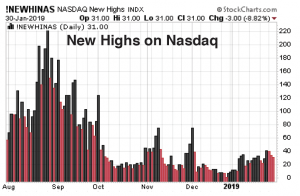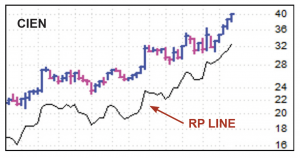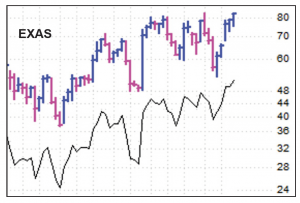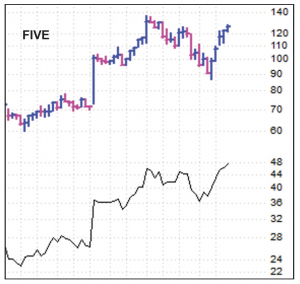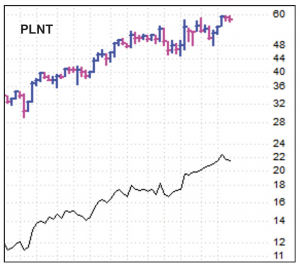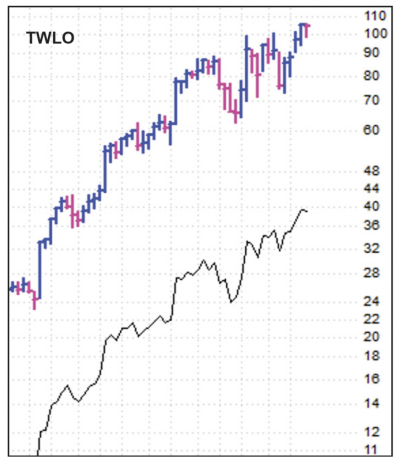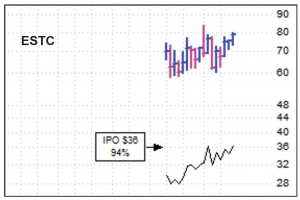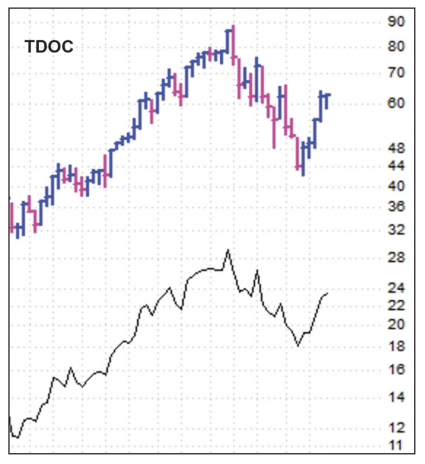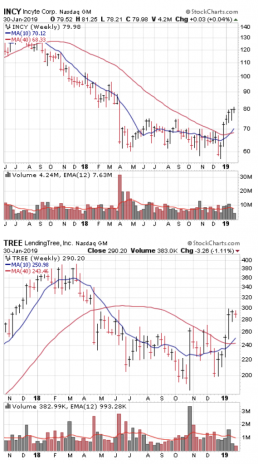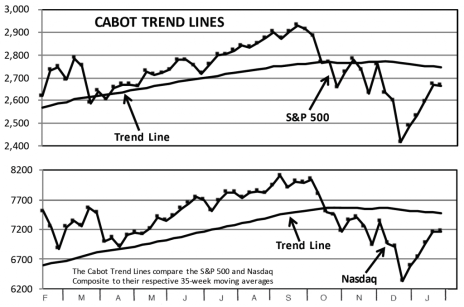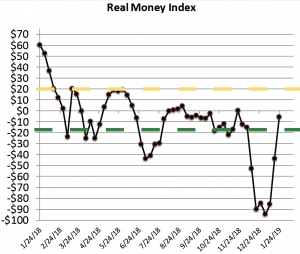The market has been acting in a near picture-perfect manner for the past few weeks, and we’ve responded by steadily adding to our exposure—we put 15% of our cash to work in early January, another 20% last week when our Cabot Tides turned positive, and tonight we’re adding one new (but familiar) name to the Model Portfolio, leaving us with around 35% on the sideline. There are still headwinds (like our Cabot Trend Lines being negative), so we’re not flooring the accelerator, but as the evidence has improved, we’ve grown more optimistic. Tonight’s issue goes over all our current stocks (including tonight’s new addition), and details a better way to “buy low” than most investors use.
Cabot Growth Investor 1412
[premium_html_toc post_id="169821"]
Going According to Script
A punishing, out-of-nowhere, three-month decline that takes apart many popular stocks and sends the indexes reeling. A wave of panic selling at the bottom that produces historic oversold readings and massive pessimism—even though many growth stocks show resilience during the final weeks of the downturn. And then a sudden turnaround that produces a rare blastoff signal, an intermediate-term green light, and a surge by the indexes that one month later still shows no sign of slowing.
The scenario above is basically the perfect Hollywood script for a major market bottom and an ensuing bull move—all the weak hands getting out over a few months, fresh leadership setting up and then a powerful advance that catches everyone by surprise. And it matches up perfectly with what we’ve seen since October!
In a nutshell, our strongest takeaway from the market right now is that it’s doing basically everything it should if it’s shaken everyone out, formed a major low and begun a new, sustained advance—including the action of the major indexes and leading stocks, sentiment (little money has flowed into equity funds since the bottom) and, recently, bullish earnings reactions from growth stocks.
That said, while the past few weeks have been picture perfect from a bulls’ point of view, there are still hurdles to overcome. For instance, we’re certainly not going to ignore our dependable Cabot Trend Lines, which are still solidly in negative territory. And it’s not as if growth stocks are necessarily running away on the upside; even during yesterday’s Fed-induced run higher, we saw just 31 stocks on the Nasdaq hit new highs (see chart to the right).
Neither of those are reasons to expect bad things, but they do tell us to take things on a day-by-day and stock-by-stock basis. With that in mind, we’re adding one more stock tonight because of the latest upmove from the market, and we’ll aim to get “pulled” into a more heavily invested stance should the evidence continue to improve.
[highlight_box]WHAT TO DO NOW: Put some more money to work. Last week, when our Cabot Tides turned positive, we bought Planet Fitness (PLNT) and another half position both in Ciena (CIEN) and ProShares Ultra S&P 500, and tonight, we’ll take another shot at Exact Sciences (EXAS), which we’ve owned twice before, but now finally looks ready to go. Our cash position will now stand near 35%.[/highlight_box]
Model Portfolio Update
Including tonight’s purchase, we’ve put nearly 50% of the portfolio back to work since the start of the month, going from a (highly defensive) cash position of 82% down to around 35% currently. We’re increasingly optimistic that the next big move in the market is probably up, so we’re aiming to be patient with our current crop of stocks, giving them a chance to consolidate recent gains and, ideally, morph into true market leaders of a sustained bull move. And, of course, we’re spending a ton of time sifting through dozens of growth stocks trying to find more new leadership to eventually add to the portfolio.
That said, there are still headwinds and earnings season is heating up, so we’re also not looking to push our luck too quickly, either. We’ll be sure to cut losses quickly should the rally run into serious trouble over the next few weeks.
Said another way, timing is vital in the market, so even with growing conviction that 2019 should be a good year, it’s still important to ride the bucking bronco and “trust, but verify” that the bulls are taking control. So far, so good, but we want to see further strength to put more money to work.
Current Recommendations
BUY—Ciena (CIEN 38)—It’s not unusual after a few good weeks of a market advance to see some extended leaders earn downgrades, and that’s what Ciena saw yesterday—one brokerage house downgraded shares based on data center spending lumpiness and tough comps, though they remain longer-term positive on the story (and did increase their price target). Not to downplay any concerns, but to us these downgrades are more about taking chips off the table after a good run as opposed to major fundamental concerns. Indeed, we think it’s very encouraging that some other firms (like Corning and Xilinx) that also are involved in the next wave of the Internet buildout (5G, data center interconnections, pushing fiber closer to users, etc.) have reported great results, with the stocks reacting positively. We’re not whistling past the graveyard—a dip into the low 30s would be abnormal and would likely cause us to cut bait—but at this point, the story is as good as ever and CIEN didn’t even fall to its 25-day line (near 36.5) before bouncing. We bought a half-sized stake in CIEN earlier in the month, and filled out the rest of the position (adding another 5% chunk) last week after the Tides’ green light. If you own some, sit tight, and if you don’t, you can get in here or on a dip of a point or two.
BUY—Exact Sciences (EXAS 90)—We bought EXAS way back in the back half of 2017 (ended up with a modest profit) and again last November (got whipped out during the market’s December meltdown), but we’re thinking the third time is the charm. The story and numbers have been terrific for many quarters and there’s little reason to see that changing—Exact preannounced very bullish Q4 results a couple of weeks ago, with revenues likely up around 64% thanks to 292,000 Cologuard tests being completed (up 66% from a year ago). And with Pfizer now pushing the product, there’s every reason to think Cologuard adoption will continue to ramp up in 2019 and beyond. (Late last year, Exact’s management forecast 60% revenue growth for this year.) However, in the market, timing is everything, and both of our prior purchases came within a few weeks of major market downmoves (January 2018 and December 2018). But, of course, that situation looks different today—the market appears to be beginning a sustained rally, and EXAS is acting just as a new leader should, being one of the first to push out to new highs. The only trick here is that earnings are likely out near the tail end of February; yes, Q4 numbers have been announced, but if the top brass changes their 2019 outlook it could be perceived negatively. To us, though, that’s a risk worth taking, given that the stock made no net progress for 13 months (wearing out many weak hands) and because the recent strength is a good sign big investors are getting in. If you want to start with a smaller-than-normal position, that’s fine, but we’ll keep it simple and add a full-sized (10% of the portfolio) position tomorrow, using an initial loss limit in the low- to mid-70s.
BUY—Five Below (FIVE 124)—FIVE continues to act well, having changed character after the market’s Christmas Eve low. As with most stocks, perspective is in order in the short term—shares bolted from a closing low of 90 in December to 123 in the second week of January, and since then, shares have made no net progress (though briefly poked to new recovery highs on low volume last week). Thus, if the stock does chop around for a while longer it would likely be normal action. Fundamentally, the retail industry as a whole looks strong; the Redbook chain store sales measure is still up nearly 6% from a year ago, which is off its highs of 9% from the holiday season but above most of the readings of the past five years. With the U.S.-China trade negotiations supposedly coming down the home stretch (March 2 deadline), the stock could easily get pushed and pulled on rumors, reports and threats in the weeks ahead, but we’re as bullish as ever on the firm’s underlying growth story. We’ll stay on Buy, though as with many stocks, further consolidation could be in order before the next push higher.
BUY—Planet Fitness (PLNT 58)—We admit that we have a soft spot for cookie-cutter stories—if the firm has a unique and defensible business and management executes on its plan, these kinds of retail firms can become institutional darlings. Five Below is one of our favorites, of course, and Planet Fitness is our recent pick. In some ways, the firm reminds us of Buffalo Wild Wings, as both companies took popular local destinations (sports bars in the case of Buffalo, fitness centers for Planet) and created national brands out of them. Planet isn’t growing quite as fast as our normal recommendation (analysts see revenues up just 11% this year), but (a) that figure is probably low as the company has been trouncing estimates in recent quarters, and (b) just as important is the intermediate-term view, and with Planet Fitness likely to boost its store count by 35% or so during the next three years (and with the count likely to rise a total of 140% or more in the long term). As for the stock, it held up great during the October-December market mayhem, and as soon as the pressure came off, shares surged on five straight days of big volume toward their highs. PLNT has tightened up since and we view it as a good risk-reward play—we obviously are optimistic the next big move is up, but there’s a lot of support in the low 50s, too, in case something goes awry. All in all, you can buy some around here.
BUY—ProShares Ultra S&P 500 Fund (SSO 107)—Normally we’d wait a bit longer to grab a position in a leveraged long index fund like SSO, possibly buying a half position when the Cabot Tides turn positive, with another half if the Cabot Trend Lines do the same. (Sometimes we go even slower—after the 2016 market bottom, we waited for the Trend Lines to give a green light before diving into SSO; the results ended up great.) This time around we accelerated our buy because of the rare 2-to-1 Blastoff Indicator, and filled out our position last week after the Cabot Tides spoke. Should the market stage a “full” retest of the December lows in the weeks ahead (down in the low 80s), our purchases would obviously prove to be a mistake, but we think the increasingly bullish evidence is a good sign that, possible short-term indigestion aside, the next major move for the market is up. All told, we’re OK taking a position here or on dips if you’re not yet in.
BUY—Twilio (TWLO 111)—Early in a new market advance, you’ll often see more “action” among the bottom names that have fallen far and fast during the prior correction, with stocks that are perched near new highs doing more chopping than advancing. TWLO was subject to that effect—the stock didn’t do anything wrong, but it battled with the 100 area for a couple of weeks. As we wrote in last week’s update, though, the overall chart evidence remained superb, as were the fundamentals—the firm’s one-of-a-kind communications platform that’s led to accelerating revenue growth and has monstrous potential as more clients sign up (61,153 at the end of September, up 32% from the year before) and current clients expand their usage (in Q3, same-client revenues rose a whopping 45% year-over-year), a trend that could pick up steam as Twilio’s newer offerings (like its Flex contact center application and, soon, its email-related offerings via the acquisition of Sendgrid) are adopted. Sure enough, TWLO ramped to new highs today on excellent volume. Some further ups and downs wouldn’t be surprising, but we think you can buy some around here or on dips. The next big event will be earnings, which are due out February 12.
BUY A HALF—Workday (WDAY 182)—We could pretty much copy and paste the same words we just said about Twilio for WDAY. After nosing to new highs a couple of weeks ago, this stock stalled out a bit and took a one-day (low volume) hit on Tuesday, but all of that was normal given the prior advance (from 142 to 175 after the market bottom, and dipping only to 164 this week). And now the buyers are back, with WDAY ripping to new highs today, partially thanks to the environment, but also due to an analyst’s report that Workday has landed Accenture (the huge consulting and professional services outfit) as a client, which will not only boost Workday’s bottom line but should lead to more big deals and, given that Oracle was the prior HR platform provider, gives investors another piece of evidence that WDAY’s cloud solution is gaining share. We bought a 5% stake in early January and will likely look to fill out the position if this rally holds. As it stands now, you can buy a half sized position here or (preferably) on dips of a few points.
Watch List
Coupa Software (COUP 87): We rave about Coupa’s story, and the stock has come to life on outstanding volume in recent days. We’re hesitant to get too heavy into software names, but COUP is definitely tempting. See page 5 for more.
LendingTree (TREE 296): LendingTree is a bit squirrely (and can be thinly traded), but after a long decline, the stock looks like a great turnaround play. See page 7 for more.
MongoDB (MDB 92): We’ve written off MDB a couple of times, but despite its huge run, big valuation and (at times) sloppy trading, the stock has repeatedly snapped back toward its highs. The big idea here is that, while there’s competition, the firm’s new-age database platform has the look of a new gold standard.
Okta (OKTA 82): OKTA continues to look like a real leader, both among the “new” cybersecurity names and the market in general. We’re still looking for a pullback or shakeout to potentially start a position.
Trade Desk (TTD 143): Similar to MDB, Trade Desk is another stock that looked worse for wear, even after the market bottomed out. The stock had a big run from May through September of last year; while a correction was due (amounting to 35% during the market decline), the fact that the run lasted just five months suggests more is in store. It’s worth keeping an eye on.
Other Stocks of Interest
The stocks below may not be followed in Cabot Growth Investor on a regular basis. They’re intended to present you with ideas for additional investment beyond the Model Portfolio. For our current ratings on these stocks, see Updates on Other Stocks of Interest on the subscriber website or email mike@cabotwealth.com.
Coupa Software (COUP 87)—There’s no doubt that cloud/enterprise software stocks are one of (if not the) leading growth sectors in the market during this nascent rally; we own a half position in one of the bigger ones (Workday) and, while we never want to get too heavy in a specific sector, we could add another given the excellent stories, huge numbers and powerful charts seen in so many names. Coupa Software is on our watch list, and we’ve always loved the story—it’s aiming to be the Salesforce.com of business spend management, with an all-in-one platform that handles sourcing, inventory, expenses, invoices, payment tracking and more. We love how the platform applies to basically every business out there (management thinks it’s a $37 billion potential market), and Coupa is the hands-down leader in the field; its platform processed $370 billion of spending in the past four quarters (up 80% from a year ago), likely saving clients $15 billion during that time. Not surprisingly, Coupa is growing rapidly, with revenues rising in the 40% range and free cash flow positive each of the past five quarters, and we don’t see any reason why growth can’t remain rapid for years to come. After a good run last year, COUP really didn’t look that resilient during the correction (not bad, but nothing superb), but the recent action has caught our eye—COUP stormed back near the top of its launching pad on its heaviest weekly volume in years and has continued to new highs since. A bit of calm trading or modest pullbacks would be tempting.
Elastic (ESTC 85)—We’re spotting increasing numbers of recent IPOs that have set up decent-looking consolidations and could be ready to run. The only issue for us: Most are too thinly traded for our tastes (and for the advisory; we don’t want to be pushing stocks up or down on our advice). Still, there’s nothing wrong if you want to take a stab at some of them, and Elastic is a high-potential name to watch. The company (which is actually based in Amsterdam) is a search company, but this isn’t about Internet search—instead, Elastic’s search is geared for the Big Data and business intelligence movement, as its software platform (dubbed Stack) is able to take in and mine all different types and formats of data. We like the pervasiveness of the solution: Stack is used by Tinder to find potential matches and by Uber to match drivers and riders in milliseconds, but it can also be used for searching unstructured data to determine cybersecurity threats, see which marketing efforts or web pages are drawing the most responses and much more. Growth has been outstanding, with revenues, billings and deferred revenue (subscription revenue makes up 92% of the total) rising north of 70% in recent quarters, and despite earnings being in the red, free cash flow is quickly approaching breakeven. The valuation is definitely up there ($5 billion market cap vs. $211 million in sales!), but impressively, ESTC held up well during the market’s fourth-quarter bloodbath and has recently pushed to new highs. Earnings are likely out in late February or early March.
Teladoc Health (TDOC 64)—We’ve been getting a fair amount of questions on some stocks we owned last year that went through the wringer but now, like most things, are beginning to show life. Teladoc is one example—after a heady run, shares plunged a whopping 53% in two and a half months (89 to 42), though they’ve rallied back to the mid 60s since the Christmas Eve low. Our thoughts going forward are (a) shares have very likely seen their worst, but (b) after a 50% downturn and steep rebound, there’s also a good chance the stock is going to need another multi-week rest sooner or later, and that’s assuming shares head higher from here. Of course, the overall story is as good as ever; Teladoc is the clear leader in virtual care, with an ever-increasing array of offerings (it recently launched advice on back pain management) that are gaining acceptance from partners and consumers, and analysts see continued solid growth this year (revenues up 32%), albeit with more red ink. Thus, we’re certainly not negative on the stock, but for us to take another swing at TDOC, we’d need to see some more strength followed by (ideally) some rest for a proper setup, which in turn would tell us big investors still think the future is bright. For now, we see other, more fruitful opportunities, but we’re certainly keeping our eyes peeled on this and other former winners to see if they can decisively regain their leadership status.
A Rare Blastoff Signal
If you’ve followed us for a while, you know that we prefer (especially early in new uptrends) to buy stocks at or near new highs. The reason: Most big winners start their runs after multi-month consolidations (launching pads) that lead to a move toward new highs. That doesn’t mean we don’t try to buy on modest dips, but most of our best performers over time were purchased at prices (and valuations) that often look too high.
With that said, there’s no question everyone loves a bargain, and our studies show that there are ways to “buy low”—though, based on the questions we’re getting on many popular names and past favorites, many investors go about it in the wrong way.
In our experience, the average investor thinks about buying low this way: “XYZ stock was a leader, and just fell sharply (40% to 60%) during the market’s fourth-quarter meltdown. But now the market is acting better and the stock is perking up (though still miles short of its old highs)—it looks like a bargain so I’m jumping in.”
Sure, that method (if you want to call it that) can work at times, especially if you’re a shorter-term player. But more often that not, these big, popular prior winners that have only recently fallen apart will—at the very least—need lots of time (months) to repair the damage, if not morph into true laggards as big investors trim positions and look for new leadership.
For instance, take a look at Nvidia (NVDA), which was one of the best performers of the 2016-2018 market advance. After falling a huge 57% in less than three months, the stock rallied five weeks in a row along with the market, moving up as high as 161. But the trend was still clearly down and this week we found out why; the company sharply cut its outlook, causing the stock to give up a chunk of its recent rally.
As a general rule, if a stock’s had a big run and has fallen 50% just during the past two or three months, be careful—short-term rallies are possible, but there’s often still more trouble (or at least very choppy trading) to come as big investors trim their positions over time.
Instead of looking at stocks that have just fallen off a cliff, the better way to buy low is to look for a company with solid growth metrics that (a) trended lower for many months, (b) bottomed out for at least a couple of months and (c) has now shown big-volume strength and lifted above its key moving averages.
Incyte Corp. (INCY) is a great example. This biotech name has always had solid growth, but that didn’t stop the stock from topping out in mid-2017 around 140 and moving down all the way to 60 by April of last year. Then came a long bottoming process, with lots of sloppiness through December, but with repeated support near 60. And now we see the stock barreling ahead on big volume, moving above its 10-week and 40-week lines. Yes, there’s still old overhead to chew through, but this is a sturdy foundation.
A similar pattern is seen in LendingTree (TREE). TREE’s retreat lasted a full eight months, which is plenty of time to wipe out the weak hands. The bottoming process after the ultimate low lasted from late October through year-end—and this year, you see the stock has catapulted above its moving averages to nine-month highs. We also like the tight trading action during the past couple of weeks, which is another piece of evidence that the buyers are in control.
Fundamentally, LendingTree offers a lot to like—it’s by far the largest online marketplace for bringing loan seekers and lenders together. One of the reasons for the stock’s fall was the drop in mortgage-related revenue, which still makes up about 28% of total revenue (though that figure is down sharply in recent years). However, the real story here is the firm’s newer products (insurance, credit cards, personal loans and more) that are growing rapidly; in Q3, while mortgage revenue declined 25%, non-mortgage products lifted 45%, leading to a solid earnings beat. Better yet, despite modeling a 10% decline in mortgage revenue this year, management still sees total revenue and earnings up 30% for 2019!
The stock is a bit thinly traded at times, which isn’t ideal, but we like the story and the turnaround in the chart. TREE is on our watch list. WATCH.
Cabot Market Timing Indicators
The evidence has been steadily improving since the Christmas Eve market bottom, with a persistent advance (lack of pullbacks), buoyant action among many growth stocks, our 2-to-1 Blastoff Indicator and, last week, a green light from our Cabot Tides. We continue to put money to work.
Cabot Trend Lines: Bearish
Our Cabot Trend Lines are showing improvement, but more upside is needed before concluding the longer-term trend has turned up. At last week’s close, the S&P 500 (by 3%) and Nasdaq (by 4.2%) sat meaningfully beneath their respective 35-week moving averages. There are other indicators (like the 2-to-1 Blastoff Indicator) that bode well for the months ahead, but we’re not going to ignore the Trend Lines, which give us a reason to go slow on the buy side.
Cabot Tides: Bullish
Our Cabot Tides turned positive late last week, as all five indexes we track (including the S&P 400 Midcap, shown here) saw their lower (25-day) moving averages begin to advance. From here, most indexes could probably sustain a 4% to 5% pullback without damaging the nascent intermediate-term uptrend. All told, the Tides buy signal is another reason to put more money to work.
Cabot Real Money Index: Neutral
Our Real Money Index has returned to neutral territory, as the monstrous outflow from equity mutual funds and ETFs fell off the moving average this week. Even so, while the panic has subsided, it’s not like investors are big believers in the rally yet—money has actually trickled out of funds since Christmas despite the strong market upmove. That skepticism is likely a good sign.
[premium_html_footer]
Send questions or comments to mike@cabotwealth.com.
Cabot Growth Investor • 176 North Street, Post Office Box 2049, Salem, MA 01970 • www.cabotwealth.com
All Cabot Growth Investor’s buy and sell recommendations are made in issues or updates and posted on the Cabot subscribers’ website. Sell recommendations may also be sent to subscribers as special bulletins via email and the recorded telephone hotline. To calculate the performance of the portfolio, Cabot “buys” and “sells” at the midpoint of the high and low prices of the stock on the day following the recommendation. Cabot’s policy is to sell any stock that shows a loss of 20% in a bull market (15% in a bear market) from our original buy price, calculated using the current closing (not intra-day) price. Subscribers should apply loss limits based on their own personal purchase prices.
Charts show both the stock’s recent trading history and its relative performance (RP) line, which shows you how the stock is performing relative to the S&P 500, a broad-based index. In the ideal case, the stock and its RP line advance in unison. Both tools are key in determining whether to hold or sell.
THE NEXT CABOT GROWTH INVESTOR WILL BE PUBLISHED FEBRUARY 14, 2019
We appreciate your feedback on this issue. Follow the link below to complete our subscriber satisfaction survey: Go to: www.surveymonkey.com/marketlettersurvey
Neither Cabot Wealth Network nor our employees are compensated by the companies we recommend. Sources of information are believed to be reliable, but are in no way guaranteed to be complete or without error. Recommendations, opinions or suggestions are given with the understanding that subscribers acting on the information assume all risks. © Cabot Wealth Network. Copying and/or electronic transmission of this report is a violation of U.S. copyright law. For the protection of our subscribers, if copyright laws are violated, the subscription will be terminated. To subscribe or for information on our privacy policy, call 978-745-5532, visit www.cabotwealth.com or write to support@cabotwealth.com.
[/premium_html_footer]


